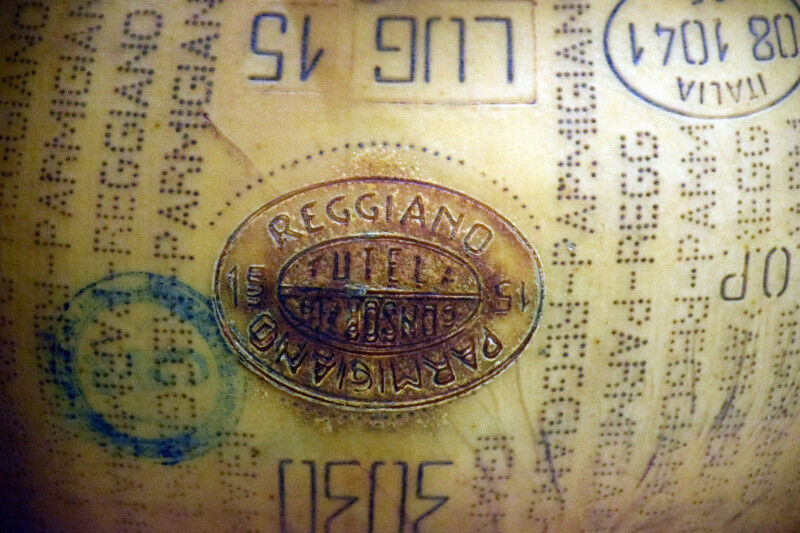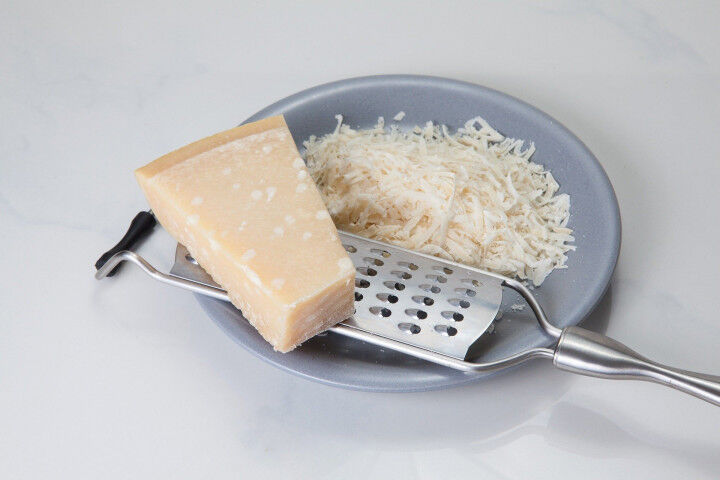What Cheese category does Parmigiano-Reggiano DOP belong to, and where is it produced?
Parmigiano-Reggiano DOP is an extremely famous cheese exported throughout the world. This cheese belongs to the category of hard pressed cheeses, which are cheeses that can be conserved for long periods of time thanks to their low percentage of water.
Parmigiano-Reggiano (DOP since 1996) is exclusively produced in the provinces of Parma, Reggio Emilia, Modena, Bologna (on the left side of Reno river) and Mantova (on the right side of Po river). In this territory alone we can find over 3,500 small farms, and more than 350 dairies which process and age the cheese for at least 12 months.
Are there specific characteristics involved in the feeding of cows that are used to create Parmigiano Reggiano DOP?
The inimitable characteristics of Parmigiano-Reggiano come from a profound bond with the territory and from the preservation of traditional production practices: cows are never given fermented or silage fodder, and feed used is free of any animal origins or food industry by-products.
The cheese itself is absent from any additives, and includes exclusively natural ferments, and a very extended long aging period.
How is Parmigiano-Reggiano DOP prepared?
Milk is stored in each farm’s dairy, and milk from an evening milking is kept through the morning in large tanks. In these tanks, the milk spontaneously undergoes a separation between liquids and fat, which is subsequently used for the production of butter.
In the morning, the liquid milk is poured into copper cauldrons with a typical upside-down bell shape. This evening milk is then blended with the milk just harvested from the farm’s cows that morning.
The addition of natural whey, rich in lactic ferments from the previous day’s ferments, and calf rennet allows the milk to coagulate.
Only the addition of calf rennet and natural whey, rich in lactic ferments obtained from the previous day's processing, allows the milk to coagulate.
The curd obtained is then broken down into tiny grains with the use of a tool called the spino. The grains are then cooked until they reach a temperature of 55°C. Once the grains have reached this temperature, they form into a collection of caseous granules on the bottom of the boiler, and into a mass.
How do we define the quality of Parmigiano-Reggiano DOP?
The exterior of each “scalzo” or wheel of cheese is branded with a unique stamp indicating the month and year of production. This distinguishes the dairy where the Parmigiano-Reggiano selection is crafted.
Each wheel is then immersed in a solution of water and natural salt. During this period, which can last more than two weeks, the cheese absorbs salt and loses water.
Afterwards, the cheeses are placed once again into the maturing warehouses: the cheese continues to lose humidity, the rind is formed and the long process of fermentation of the paste begins.
The Consortium requires these 12 months for certification, and it is during these 12 months that the cheese will acquire the special qualities the discipline requires in order to bear the PDO Parmigiano-Reggiano name. Only following these 12 months, the cheese may continue on its long aging process, going past its initial 30 months.
What are the sensorial characteristics of Parmigiano-Reggiano DOP?
When tasting a Parmigiano-Reggiano, it’s impossible not to take note of the complexity of aromas and flavors generally expressed. These elements are present thanks not just to the cow’s nutrition, but also thanks to the long ageing times of the cheese.
The sensorial characteristics of this cheese can therefore be considered in continuous evolution.
Parmigiano-Reggiano DOP aged 12-18 months
This variety has a rather accentuated lactic base (milk, ricotta cheese, yogurt, butter), although the overall flavor isn’t necessarily intense. A vegetable note like grass, boiled vegetables and sometimes fruit or floral notes accompany the cheese.
The cheese manages to be both sweet and acidic at the same time. The cheese’s texture is granulated, with a friability and solubility that begin to become noticeable and appreciable.
Recommended food pairings: fresh fruit (pears, apples, grapes and strawberries), raw vegetables (celery), fruit-based chutneys, and light honeys.
Parmigiano-Reggiano DOP aged 22-28 months
Parmigiano-Reggiano cheese here has reached its optimal age for tasting. This is the ideal age for the cheese to express its aromas on the nose and palate, and features a wealth of smells and aromas that are perfectly balanced and harmonious.
The lactic base of this variety of Parmigiano-Reggiano is enriched, and while the notes of milk and butter are present, we can also discern hints of melted butter or bread crust.
Fresh fruit (pineapple, banana) and citrus fruits make their appearance next along with hints of dried fruit and spices (nutmeg). The umami may already be perceptible.
The flavor evolves into a balance of sweet and savory. This ageing also brings the cheese to a perfectly soluble texture that’s both crumbly and grainy.
Recommended food pairings: Dried fruits (walnuts, hazelnuts, dried figs), aromatic honeys, carpaccio and roast-beef.
Parmigiano-Reggiano DOP aged Over 30 months
This ageing length allows the cheese to display a discreet maturation that’s drier, yet more friable and granular. The cheese’s flavor is stronger and spicier, while elements of spices and dried fruit are definitely predominant.
Recommended food pairings: Traditional Balsamic Vinegar of Modena DOP, aromatic honeys, particular jams and compotes (of red onions, bitter oranges, figs, pears and grapes).
When is Parmigiano-Reggiano DOP good to eat?
Parmigiano-Reggiano goes well with any meal of the day thanks to its rich calcium and phosphorus levels. The cheese is naturally tasty, and high in protein and is naturally lactose-free.
Why is Parmigiano-Reggiano a great food for athletes?
The cheese is an ideal snack for athletes as it can be used in a targeted way pre or post physical activity. Parmigiano-Reggiano provides ready-to-use saturated fats, and can help replace salts and amino acids.
Where did Parmigiano-Reggiano get its name?
Parmigiano-Reggiano maintains a very strong link to its place of origin, evident even in its name. As the cheese is made in both the Parma and Reggio-Emilia provinces, a clear link to its territory is fully noted.
What wines should I pair with Parmigiano-Reggiano DOP?
- Ribolla Gialla DOC (pair with a young Parmigiano-Reggiano DOP)
- Lambrusco di Sorbara DOC (pair with a young or aged Parmigiano Reggiano)
- Primitivo di Manduria DOC (pair with a very mature or very old Parmigiano Reggiano)




